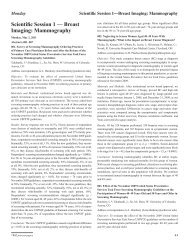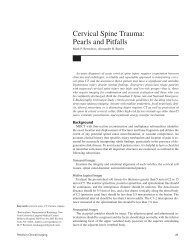Create successful ePaper yourself
Turn your PDF publications into a flip-book with our unique Google optimized e-Paper software.
<strong>MRI</strong> <strong>of</strong> <strong>Benign</strong> <strong>Female</strong> <strong>Pelvis</strong>Fig. 8—Uterine fibroid.A, Coronal T2-weighted image shows lesscommon, hypercellular uterine fibroid (F)<strong>of</strong> high signal intensity, surrounded by lowsignal-intensitymyometrium.B, Sagittal T2-weighted image shows hyalinedegeneration with speckled areas <strong>of</strong> low andhigh signal intensity.C and D, Coronal T1-weighted fat-saturatedimages before (C) and after (D) IV gadoliniumadministration show high signal intensity beforecontrast administration, consistent with bloodproducts, and lack <strong>of</strong> enhancement after contrastadministration, consistent with hemorrhagic(also known as red or carneous) degeneration.ABT2-weighted images (i.e., lower SI than is seen with usual fibroids)or a speckled pattern <strong>of</strong> low SI and high SI (Fig. 8).Findings indicating hemorrhagic degeneration may depend onthe time since degeneration, but usually hemorrhagic degenerationis seen as high SI on T1-weighted images within theentire fibroid and lack <strong>of</strong> enhancement after administration <strong>of</strong>contrast material (Fig. 8). Calcification along the periphery <strong>of</strong>the fibroid can occur and is best appreciated on gradient-echoT1-weighted images. A rare variation is the lipoleiomyoma,consisting <strong>of</strong> mature adipose tissue interspersed with smoothmuscle cells and fibrous tissue.Details <strong>of</strong> the variable imaging characteristics on <strong>MRI</strong> canalso play important roles in determining the optimal treatment.Because uterine artery embolization exerts its treatment effectthough the release <strong>of</strong> microparticles into the feeding vessels <strong>of</strong>the fibroid and <strong>MRI</strong>-guided focused ultrasound surgery causestemperature elevation in fibroid tissue with resultant celldeath, both <strong>of</strong> these treatment options require an intact bloodCDsupply to the fibroid before treatment. SI on T2-weighted imagingis also an important detail that may determine optimaltreatment; for example, it is usually easier to induce sufficienttemperature elevations in typical fibroids (i.e., those <strong>of</strong> low SIon T2-weighted images) through <strong>MRI</strong>-guided focused ultrasoundsurgery, and these have a better outcome than hypercellularfibroids.SummaryBecause <strong>of</strong> inherent tissue contrast, <strong>MRI</strong> <strong>of</strong>fers much informationon benign physiologic and pathologic processes in thefemale pelvis. Although <strong>of</strong>ten not the first line <strong>of</strong> imaging forbenign pelvic disease, <strong>MRI</strong> can facilitate definitive diagnosisonce key imaging characteristics <strong>of</strong> the physiologic or pathologicprocess are known.REFERENCES1. Troiano RN, Lange RC, McCarthy S. Conspicuity <strong>of</strong> normal and pathologic femalepelvic anatomy: comparison <strong>of</strong> gadolinium-enhanced T1-weighted images andBody <strong>MRI</strong> 229
















